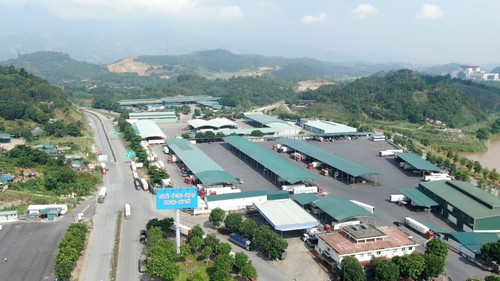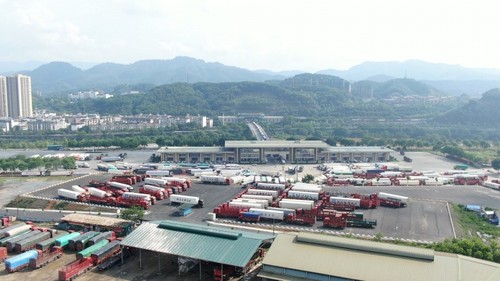 Lao Cai province has 45 warehouses, 5 of which are at the provincial level. (Photo: VOV) Lao Cai province has 45 warehouses, 5 of which are at the provincial level. (Photo: VOV) |
The Lao Cai Border Gate Economic Zone is the only economic zone in northern Vietnam with an international border gate located in the inner city, which has create favorable conditions for import-export activities, tourism, and services between Vietnam and China.
The Lao Cai-Hekou international border gate on the economic corridor connecting Kunming, Lao Cai, Hanoi, Hai Phong, and Quang Ninh embraces a particular advantage - an important gateway for the trans-shipment of goods from ASEAN countries through Vietnam's seaports to China’s southwestern provinces.
Under the master plan to turn Lao Cai into an economic trade center, the province is expected to become a key driver of regional economic development and a logistics center connecting ASEAN countries and China’s southwestern region.
Economist Doan Cong Khanh says the Lao Cai administration needs to build a modern, comprehensive logistics system and a mechanism to attract investors.
“Building a logistics system in Lao Cai province will be a key to the success of the economic trade center,” said Khanh, adding, “Increasing coordination between the economic zone, the Lao Cai administration, other regions, and the business community, is important to promote Lao Cai’s border economic zone and address issues concerning infrastructure and the logistics network.”
 Lao Cai has planned a logistics area of 300 hectares and is calling for investment. (Photo: VOV) Lao Cai has planned a logistics area of 300 hectares and is calling for investment. (Photo: VOV) |
Lao Cai’s inter-regional and international transportation infrastructure comprises highways, railways, waterways, and – in the near future – airways.
Covering approximately 16,000 hectares, the Lao Cai Border Gate Economic Zone has relatively complete infrastructure and services and is one of Vietnam’s eight key border gate economic zones.
Nguyen Xuan Quynh, Chairman of the Viet Trung Logistics Company, says Lao Cai province has 45 warehouses, 5 of which are at the provincial level, offering customs declaration, warehousing, transport, distribution, and trading services.
But in order to become an international logistics center, the province needs to expand infrastructure, improve human resources, and apply state-of-the-art technologies to attract investment.
Quynh added that a closed logistics center must ensure a complete system of regulatory mechanisms and policies, which includes a customs declaration process and packaging and export services.
But “The current logistics centers of Lao Cai and companies doing business at the Kim Thanh border gate don’t have a complete model yet. We hope Lao Cai will soon have such a system,” according to Quynh.
Lao Cai has planned a logistics area of 300 hectares and is calling for investment. Nguyen Van Hoi, Director of the Institute of Industrial Strategy and Policy Research, said, “We encourage businesses of all economic sectors to engage and cooperate in the development of a logistic center in the province. The available land policies offer incentives for both domestic and foreign investors.
He underscored the need to maximize such mechanisms and trade promotion programs, and provide as much support as possible for human resource training, technology, and equipment.
Launched last March, a project to build a bridge crossing the Red River and running through Ban Vuoc commune, and a transportation project running through Vietnam’s Bat Xat area and China’s Pa Chai, are expected to be completed in the near future.
These projects will realize Lao Cai’s aspiration of building a cross-border economic cooperation hubs and boosting trade and tourism activities between Vietnam and China as well as realizing the goal of becoming an economic hub of the country.